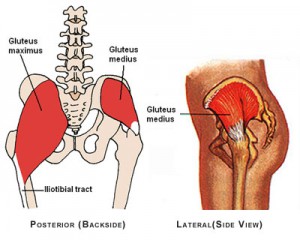It would be hard to quantify just how many people lack access to their deep gluteal muscles, gluteus medius, and minimus.
If I had to guess it is a majority.
Gluteus medius and minimus are two-thirds of the gluteal group which also includes gluteus maximus.
Gluteus maximus differs from gluteus medius in that it is an extensor muscle while gluteus medius and minimus are rotators, abductors (pull the leg away from the body), and dynamic stabilizers.
In between gluteus medius and minimus and gluteus maximus, we have the piriformis muscle, an external rotator that along with gluteus maximus connects the legs to the spine from the back of the body.
It is fairly easy to test the strength of gluteus medius—stand on one leg and see what happens to your pelvis.
Does it drop on one side or pull backward? Ideally the muscles of the standing hip stabilize and nothing needs to shift in the pelvis.
Weak or inhibited gluteus medius and minimus muscles often correlate to a tight piriformis muscle.
If the piriformis is tight it limits the available space that the gluteus medius and minimus have in order to function.
If the piriformis is weak, or loose, it will create a different set of problems for the gluteal muscles.
To a certain degree, the piriformis helps to stabilize the pelvis, and its lack of tone can negatively affect the activity of the gluteus medius and minimus.
There is a belt of muscles surrounding the pelvis – the three gluteal muscles, the psoas, piriformis, tensor fascia latae rectus femoris— that all suffer if one suffers.
To that end, a tight IT band and tensor fasciae latae particularly impact the gluteus medius and minimus.
For the most part, people with tight IT bands also tend to be tight in the gluteus maximus and piriformis.
It is a vicious cycle that is ultimately fixed by realigning the pelvis with the legs under the hips and learning to walk in a way that uses all of our muscles correctly.
***

